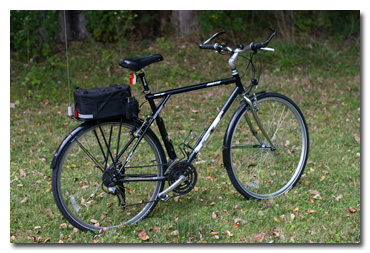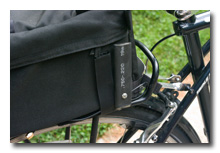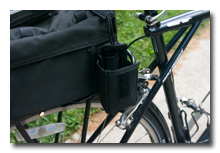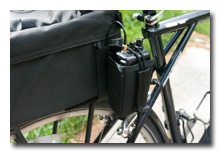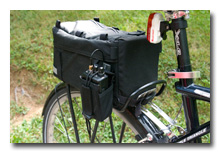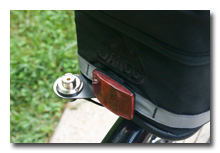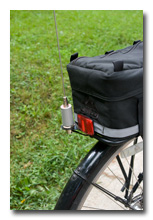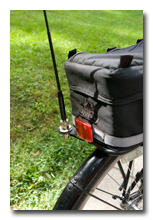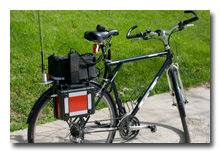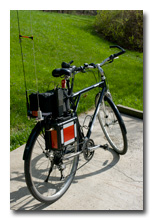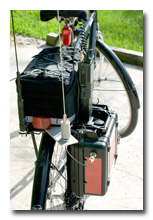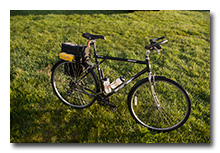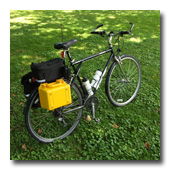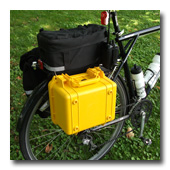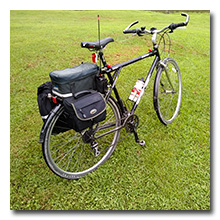by William Eric McFadden, WD8RIF
I am an avid bicyclist and enjoy combining amateur radio with my cycling. I have built a VHF/UHF FM bicycle-mobile station and I carry my QRP HF station to field events on my bicycle.
I built my bicycle-mobile station in the winter of 2004 in order to be able to ride bicycle-mobile helping the Athens County Amateur Radio Association (ACARA) provide communications support to the 2004 running of the Athens (Ohio) Marathon (link). For the 2004 event, the 2m HT and antenna system were completely successful; I could successfully hit the repeater over the entire 26.2 mile course except for one small space near the far-end of the course.
I have ridden bicycle-mobile in support of the Athens Marathon every year since 2004. Starting with the 2005 running of the Athens Marathon, I also carried an APRS station on the bicycle.
In addition to the Athens Marathon, I've used my bicycle-mobile station in support of the Athens MS-Walk, Run Like Hell 5K Run for Cystic Fibrosis, and Pelotonia.
Note: This page reflects the current bicycle-mobile station built around a Yaesu FT-60R VHF/UHF handheld. The page describing the older station, which was built first around an ICOM IC-02AT 2m handheld and later around an ICOM IC-2AT 2m handheld, is archived and is available here.
-
The bicycle is a 1997-vintage GT Arette steel-frame 21-speed hybrid. To this bicycle I have added full fenders, a rear rack and bag, a Sigma Sport BC-400 computer, a SpeedV WTB saddle, a Princeton EOS (1-watt Luxeon LED) headlight, a Planet Bike Superflash ½-watt LED taillight, two water bottle cages, handlebar extensions, Shimano SPD clipless pedals, kickstand, and a tire pump. The front wheel and fork have been replaced, the originals having been trashed in an accident. The rear wheel was replaced after I started breaking spokes and again when the bearing destroyed itself. The crank, the sprockets, the chainrings, the chain, and the rear derailleur have all been replaced, after the originals wore out. The bicycle is currently equipped with 22-32-42 chainrings and 7/13-28 cogs.
(Since I upgrade the bicycle on an ongoing basis, the photos on this page may not reflect the current configuration of the bicycle.)
-
The radio is a Yaesu FT-60R 2m/70cm handheld. The HT rides in a a Western Case Company (link) #26 nylon HT case which slips onto a steel bracket bolted to the bicycle's rear-rack (photos: 1 | 2 | 3 | 4). The nylon case securely carries the HT and provides vibration-reduction and some protection to the HT in case of accident. I have found that this location for the radio works well; I can adjust the volume and squelch from the seat while under way. If I need to change frequency, I'll need to stop, dismount, and remove the HT from the nylon case in order to unlock the keypad and tuning knob.
The radio location was carefully chosen to not interfere with mounting of the KX3 Travel Kit, the KX2 Mini Trave Kit, the APRS Tracker in a Pelican Case, or a rear pannier. I would like to eventually replace the steel bracket with a lighter aluminum one.
-
I tried handlebar-mounting of the FT-60R but quickly found it to be unsatisfying—there was just too much mass, both physically and aesthetically, on the handlebars with the HT mounted there, and I didn't like the vibration the HT was subjected to.
-
The permanent antenna mount is an SMA-equipped MFJ-341SS SO-239 antenna-mount on a steel bracket bolted to the bicycle's rear-rack (photo). The antenna-mount location was carefully chosen so that the mount won't interfere with the mounting of panniers to the rear-rack.
The antenna is a a black Jetstream JTM-3B (link) 2m/70cm SO239-mount mobile antenna. This antenna is a ground-independent 1/2λ on 2m and a ground-independent double 5/8λ on 70cm. If I need an antenna only for 2m, I can instead use a taller, higher-gain Diamond DP-NR2C 2m 6/8λ ground-independent mobile antenna (link)
For short radio-equipped rides, or when I don't want to mount the larger antenna, I mount my Diamond SRH77CA dual-band HT whip on the antenna-mount using a PL259-to-SMA adapter (photo). Even when I do use the larger antenna, I carry an HT antenna on the bicycle so I can use the HT as a handheld, not mounted on the bicycle, if the need arises.
-
On occasion, particularly when I intend only to listen to the radio while riding and don't want to fuss with the speaker-mic, I ride with the Diamond SRH77CA dual-band HT whip installed directly on the HT instead of mounting an antenna on the bicycle. On these occasions, I install a weather-proof cap on the SO-239 antenna-mount (photo) to keep grit and moisture out of the connector.
UPDATE 2019-04-16: In preparing for the 2019 Athens Marathon, I discovered that this MFJ-341SS in the permanant antenna mount has failed: the center pin of the SMA connector had gotten shoved into the connector body enough that it provided poor or intermittent connection to an HT or APRS tracker. I could pull the pin back out with pliers but the pin got shoved right back in when I connected to a radio. For Marathon 2019. I replaced the MFJ-341SS with an SO-239 bulkhead adapter and used appropriate adapters to connect to my radio.
-
After initially encountering trouble trying to use a speaker-mic with the FT-60R, I finally found that the MFJ-282Y behind-the-head boom-mic headset (photo) works well with the HT and can be comfortably worn with a helmet. While testing the MFJ-282Y, I received reports of good, strong audio and no wind-noise.
The problem I was encountering while trying to use a speaker-mic with the FT-60R is the speaker-mic socket on the FT-60R. The socket is located on the side of the HT and only a very slight tug is required to pull the speaker-mic jack partially out of the socket and lock the HT in transmit mode. Yaesu's solution to this problem is to include a strain-relief loop on the MH-34 speaker-mic's cord; this loop goes over the HT's antenna and prevents the speaker-mic jack from being pulled out of the socket. While using the MFJ-282Y headset, I loop the cord around the HT's belt-clip to provide strain-relief.
Because the cord on the Yaesu MH-34 speaker-mic is too short for use with the radio mounted behind me on the bicycle, I tried using a Radio Shack speaker-mic and a Yaesu CT-44 two-pin adapter cable; the combined length of these two items is just adequate for comfortable use on the bicycle. Unfortunately, the CT-44 and the Radio Shack speaker-mic fail to function properly with my second/replacement FT-60R. Receive audio through the speaker-mic is very weak and distorted and twisting the CT-44 connection at the radio causes the FT-60R to change frequency. Twisting the CT-44 connection without the Radio Shack speaker-mic connected doesn't seem to affect the frequency setting so the problem might be the Radio Shack speaker-mic.
UPDATE: For the 2016 Athens Marathon I finally resolved the issue with the FT-60R speaker-mic jack: I physically removed the rubber grommet from the HT's socket to allow the speaker-mic plug to fit more securely and reliably. A strain-relief of some sort is still needed, however. I have a pair of four-conductor extension cables, one about 6' long and one about 3' long, that hadn't worked reliably before I removed the grommet but both work very reliably now. I wrap one or more turns of the cable around the HT's belt-clip as a strain-relief before securing the HT in the nylon case. During several test-rides and during the entirety of the 2016 Marathon, I experienced no issues whatsoever with this arrangement. For the 2016 Marathon, I used my Yaesu MH-34 speaker-mic attached to a lanyard worn around my neck; the MH-34 produced fine receive audio and I received reports of excellent transmit audio. I have not yet tested the MFJ-282Y headset with the modified HT. (Indeed, I have become dissatisfied with the way the MFJ-282Y fits on my head and may never actually use it.)
UPDATE 2019-04-16: For the 2019 Athens Marathon, I chose to carry the FT-60R on my chest, clipped to a pocket on a reflective safety vest, with the MH-34 speaker-mic connected directly to the HT and clipped to a lanyard. A loop added at the vest's shoulder kept an HT-mounted MFJ-1714S extendable ½-wave antenna vertical as I rode. This arrangement worked well and the FT-60R and mic both seemed to survive the heavy rain that fell during the ride. It was nice to not be tied to the bicycle with a speaker-mic cord.
-
For support of the Athens Marathon, the MS-Walk, and other events, I carry an Automatic Packet Reporting System (APRS) station on the bicycle in addition to the voice-net radio. An SMA-equipped MFJ-341SS SO-239 antenna-mount is mounted on an aluminum bracket which I temporarily mount on the rear rack of the bicycle adjacent to the permanent antenna-mount (photo). On this mount I can install a Larsen Kūlrod MHW-150 2m 1/2λ ground-independent mobile antenna or a taller, higher-gain Diamond DP-NR2C 2m 6/8λ ground-independent mobile antenna.
I can easily mount either of my APRS trackers to the bicycle. One of the ACARA's Byonics Micro-Trak AIO tracker travels safely bungied to the top of my Jandd Mountaineering (link) rear-rack trunk-box using the trunk-box's clever elastic straps. My larger Earthmate/GST-1/TinyTrak3/IC-2AT APRS Tracker in a Pelican Case safely travels on the same easy-to-mount, easy-to-remove rear-rack fixture I use to transport the KX3 Travel Kit on the bicycle (photos: 1 | 2).
The photos above show the bicycle-mobile configuration used in support of the 2015 Athens Marathon. I used an IC-2AT HT as the voice radio for this event because I hadn't yet solved the FT-60R bicycle-mobile speaker-mic connection problem.
Visit the Bicycle-Mobile Archive Page to see the previous APRS installations.
UPDATE 2019-04-16: In preparing for the 2019 Athens Marathon, I discovered that the MJF-341SS APRS antenna mount has failed in a way identical to the failure of the MFJ-341SS voice-radio antenna mount (see above). I removed both MFJ-341SS mounts and the aluminum second bracket from the bicycle, and installed an SO-239 bulkhead adapter in the permanent antenna bracket. Since I was using an HT-mounted antenna for the voice-net radio, I was able to use my permanent antenna mount for the APRS antenna. I carried a second FT-60R in the rear-mounted pouch so I could hear my own packets and be assured that the old APRS tracker continued to function properly.
UPDATE 2023-04-16: For the 2023 Athens Marathon, I carried one of the ACARA's Byonics MicroTrak AIO intead of my ancient APRS Tracker in a Pelican Case due to issues with the latter during the 2022 running of the event. The MicroTrak AIO was mounted using Velcro to an aluminum brackets extending off the right-side of my bicycle's rear-rack.
APRS References / Links of interest:
- APRS.org
- Public Service Event APRS Web Mapping for Wireless Devices by W8KVK and KA9AFT, a presentation to the 2011 TAPR and ARRL Digital Communications Conference (PDF)
- Byonics Micro-Trak AIO
- Byonics TinyTrak3
- Byonics GST-1 GPS Sentence Translator (page gone but archived here here.)
-
I don't operate HF while riding the bicycle but I do use my bicycle to transport myself and my HF equipment to HF field operations.
I've gone through several iterations of bicycle-portable stations.
My KX3 Travel Kit was initially carried on the bicycle using the same easy-to-mount, easy-to-remove fixture I had built to transport the smaller and much lighter KX1 Mini Travel Kit. (photos: 1 | 2).
Using the original fixture, I carried the KX3 Travel Kit on the bicycle on several bicycle-portable operations. Although the station traveled safely, I eventually came to the conclusion that my original fixture was really not rigid enough to support the greater weight of the KX3 Travel Kit without bending. In July of 2018 a local machinist who's also an active bicyclist fashioned me a new easy-to-mount, easy-to-remove fixture out of strong ¼" steel rod. (Visit the KX3 Travel Kit to see the bicycle-portable operations I've performed with the KX3 Travel Kit.)
I built a much lighter K1 Travel Kit for bicycle-portable HF operations. I've carried the K1 Travel Kit on the bicycle for a Parks on the Air (POTA) activation of Wayne National Forest (K-4521), and the 2021 Flight of the Bumblees event.
I replaced the original KX3 Travel Kit with the KX3 Mini Travel Kit for bicycle-portable HF operations. This kit was much lighter than my Enhanced KX3 Travel Kit and is slightly heavier than my K1 Travel Kit. (Visit the KX3 Mini Travel Kit page to see the bicyle-portable operations I've performed with the KX3 Mini Travel Kit.)
I replaced the KX3 Mini Travel Kit with the KX2 Mini Travel Kit for bicycle-portable HF operations. This kit was much lighter than the KX3 Mini Travel Kit and travels much better on the bicycle. (Visit the KX2 Mini Travel Kit page to see the bicycle-portable operations I've performed with the KX2 Mini Travel Kit.)
Visit the Bicycle-Mobile Archive Page to see how the QRP Station in a Bag, the K2 Travel Kit, and the KX1 Mini Travel Kit were transported via bicycle.
